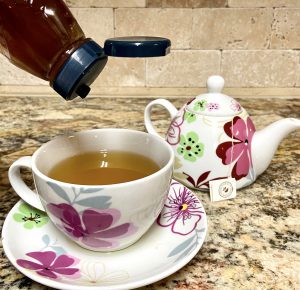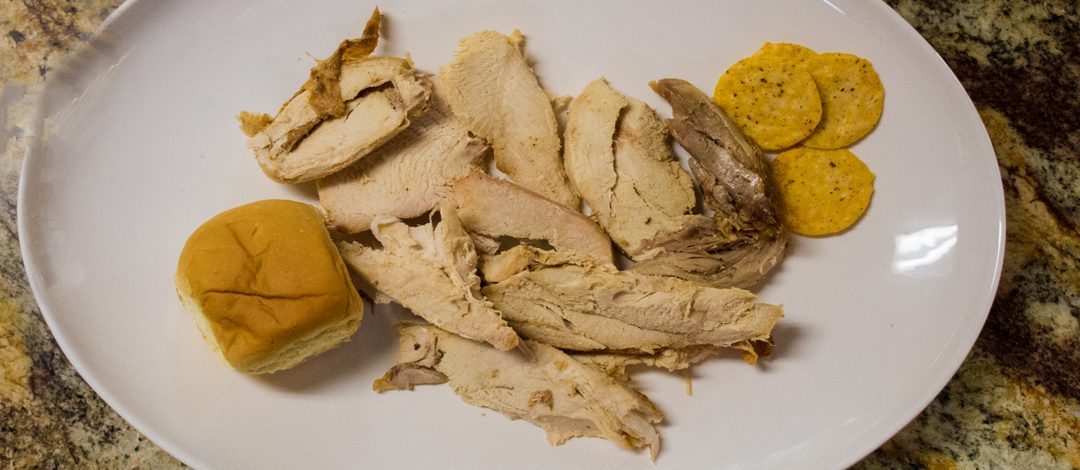
by Ginny Hinton | Aug 8, 2021
If you’ve tried to find nutrition information in the midst of the Covid-19 pandemic, you probably got more than you bargained for. Recently, I searched “nutrition and COVID-19” and in less than one second, I got 590,000,000 hits. That’s a lot of information! With so much health and nutrition information available, especially connected with the ongoing pandemic, it can be TOUGH to separate fact from fiction. What makes it even tougher is that everyone seems to be passionately and totally convinced that their information is the right answer. How do you tell the hype from the truth?

Confusing Nutrition Choices
Photo Source: Ginny Hinton
The best way to protect yourself against questionable information and products is to become an informed consumer. That can be challenging as so many of us are becoming more used to getting our information from social media, websites, advertisements, friends and family. While information from those sources can be accurate, very often it is misleading. Use the following tips to evaluate nutrition information:
Know Your Experts:
Have you ever seen nutrition advice from a “nutritionist” or “diet counselor”? Beware, because those terms aren’t regulated, and almost anyone can use them to look like an expert. Registered dietitians (RD) or licensed dietitians (LD) hold specialized degrees and are good sources of solid nutritional information.
Media Sources:
The internet, books, newspapers, and magazines can be good sources of information, if you know where to look. If you’re surfing the net, select websites from credible web addresses like ones ending in .edu (universities or medical schools), .gov (government agencies), or sometimes .org (not-for-profit research and education). If you’re reading an article, always look for the author’s qualifications and membership in a professional nutrition organization. With all media, check the sources they used (If they don’t cite credible sources you can check, that’s a big red flag) and scan to the bottom to make sure they’re not trying to sell a product. If you can buy a “miracle” product, a solution, or a quick fix from them, watch out! Their information may be convincing, but it is likely biased or incomplete. At best, it calls for caution and some deeper research.
The flood of health and nutrition misinformation isn’t going away, but learning to be an informed consumer is a powerful step in learning to protect yourself from being duped.

by Ginny Hinton | Feb 10, 2021
If you’re the parent of a “big kid” between the ages of 5 and 12, you’ve probably scratched your head at some point wondering how, where, and in what they should be traveling. There are more options now than ever! Unfortunately, many parents and caregivers make a dangerous choice, without even knowing they could be putting their kids in jeopardy. Following are some of the options for safe travel with older children, including how and why each might work for you:
BELT POSITIONING BOOSTER SEATS
Unlike a car seat, a booster is a positioner, not a child restraint. Its main purpose is to keep the seat belt on the child’s strong hips and collar bone. With a booster, the lap portion of the belt runs under an armrest or clip which holds it low on the hips and upper thighs. This positions the lap belt so that it can’t cut into the child’s soft abdomen, causing serious or potentially life-threatening injuries. Most boosters also position the shoulder belt to keep it flat across the collarbone and protect the neck. An updated study of booster seat effectiveness (Pediatrics, 2009) concluded that children ages 4-8 in boosters are 45% safer from nonfatal injuries than children in seatbelts. The study didn’t find any difference in preventing injury between backless and high-back boosters. Some parents prefer to use high-back boosters because they offer some side-impact protection and give their children a place to lay their heads if they fall asleep. Others prefer the convenience of a lightweight backless booster that can easily travel with the child and be moved between vehicles. A backless booster will NOT work if the vehicle headrest comes below the child’s ears because of the danger of whiplash from rear-end crashes. A child can safely move to a booster seat when he/she has outgrown a car seat by weight and height, as long as the child is mature enough to stay in position while traveling. This usually happens between ages 5-7 but depends on the individual child.

Credit: G. Hinton
VEHICLE LAP-SHOULDER BELTS
How do you know when your child is ready to “graduate” to an adult seatbelt? Because the height and depth of seats vary from vehicle to vehicle, and all children are not made exactly alike, there is no specific height or weight guideline. Instead, there is a simple 5-step test as follows:
• Is your child sitting all the way back in the seat?
• Do the child’s knees reach the edge of the seat without scooting?
• Do the child’s feet touch the floor?
• Does the shoulder belt cross the child’s collar bone and not his/her neck?
• Is the child mature enough to stay in position during the entire trip?
If you can answer “yes” to every question, your child is ready to use an adult seatbelt in that vehicle. If not, no matter what your child’s age, it might be best to continue using a booster seat for a while. When a child is too small sit in an adult seatbelt, the lap belt will slide up onto his/her stomach. In a crash, the belt will keep tightening because there is no bone or other object (i.e. the armrest of a booster) to stop it. During the crash, everything has to stop so fast that it causes the belt to put extreme force on the internal organs and spine, causing the organs to rupture and the spine to snap or fracture. This cluster of injuries is called “seat belt syndrome” and can be severe. Using a booster until your child is big enough to fit the vehicle seat eliminates the risk.

by Ginny Hinton | Aug 17, 2020

Honey or Sugar
Photo Source: Ginny Hinton
Sugar or honey? The debate rages on, with honey probably edging out sugar in popularity. Many people use local honey because of it’s supposed benefit to allergy sufferers (immunotherapy). Others prefer it because it’s processed less than sugar, or because they simply love the taste.
People have been eating honey – or slathering it on their bodies – for hundreds of years. In ancient times, honey was used as a sweetener, as medicine to heal wounds, to relieve stomach problems, and even to fight bad breath. It has many of the same uses today. Honey contains trace amounts of acids that contribute to its antimicrobial activity, so when used on the skin it really can help heal wounds and reduce scar formation. The antioxidants in honey have been linked to properties that may fight cancer. Honey inhibits inflammation, leading to a protective effect for the heart and the whole cardiovascular system, and it’s a great remedy to help ease a bad cough. Does local honey really relieve allergies? There is some anecdotal (personal) evidence, but the jury is still out on that with no consistent clinical study results.
So, how do honey and sugar compare nutritionally? To start, both are carbohydrates, made up mainly of glucose and fructose. The body breaks them both down quickly and they each cause a spike in energy and blood sugar levels, although honey has a somewhat gentler effect. Honey weighs in with more calories at 68 per tablespoon versus sugar’s 49 calories per tablespoon. To balance out the calorie factor, honey is sweeter than sugar, so you may need to use less of it in your food. Honey may also be easier to digest because bees have already added enzymes that start to break it down. The bottom line is that both sugar and honey are sweeteners, they are nutritionally very similar, and using too much of either can lead to unwanted consequences such as weight gain, risk of illness, and tooth decay. Whether you use sugar or honey, it’s a great idea to limit consumption. The following tips may help, whichever sweetener you decide to use:
* Cut the amount of sweetener you use for drinks or
cooking in half and see if you still like the taste.
* Cut sweetener in baking by 1/3 or substitute mashed
banana for the sweetener.
* Add spices to substitute for some of the sweetener in a
recipe. Examples that add flavor without the calories are
almond, vanilla, and cinnamon.
Whatever tip you use, you’ll be ahead of the game if you can gradually cut the amount of sweetener you use, whether for cooking, baking, or drinking.
For more information about honey, sugar, or general nutrition, contact your local UF/IFAS Extension Agent.

by Ginny Hinton | Nov 30, 2019

Safe and delicious holiday leftovers
Photo Source: UF/IFAS
For some of us, the best part of holiday eating is snacking on the leftovers. There’s just nothing better for a post-holiday lunch than a turkey sandwich with some cranberry dressing. With a little care and attention to detail, holiday foods can be safe and delicious for several days after the big event.
So, what do we all need to know about holiday food safety? Take a look below for some quick and easy tips.
Reheating foods in the oven: Set your oven temperature no lower than 325˚F and reheat to 165˚F for turkey or chicken. Reheat ham to 145˚F. You will need a meat thermometer to check the temperature. If you don’t already have one, they’re easy to find and fairly inexpensive. To keep your meat moist, add a little broth or water and cover it with foil or an oven-proof lid.
Reheating foods in the microwave: To keep your turkey or chicken moist, sprinkle a little broth or water and cover it. You won’t need a lot of extra moisture for microwave cooking. If your microwave doesn’t have a revolving tray, be sure to rotate the meat for even heating. Let it stand for a minute or two after heating, as it will continue to cook for a bit. Just like with oven reheating, use a meat thermometer and heat poultry to 165˚F, ham to 145˚F.
Storing your turkey: It may be a painful thought, but if any turkey, stuffing, or gravy gets left out at room temperature for more than two hours, it needs to be thrown away. It’s better to waste food than to risk getting sick, especially over the holidays! Divide leftovers into small portions so they will quickly and evenly cool. Store in the refrigerator or freeze in appropriate containers.
Important Tips: Use refrigerated turkey, stuffing and gravy within four days. If you freeze your leftovers, use them within six months for best taste and quality. Not sure how long something’s been in the refrigerator or freezer? The old maxim still holds true: When in doubt, throw it out.
Best wishes to you for a safe and happy holiday season!

by Ginny Hinton | Jul 5, 2019
Summer has hit the Florida Panhandle with a vengeance this year! If you’re out in the heat it’s especially important to make sure to keep your body well-hydrated. After all, water is the single largest component of our body, and it’s essential for life.
Recommendations for how much to drink vary depending on several factors including your age, how active you are, how hot it is outside, what you’re wearing, and if you have certain medical conditions. A pretty good “ballpark” from the Institute of Medicine Food & Nutrition Board (IOMB) is to drink around 3 quarts of water a day for women and around 4 quarts for men. It’s important to start hydrating even before your feet hit the floor in the morning, because your body has been losing fluid while you slept. And if you can go more than 4 hours during the day without taking a bathroom break, you’re probably already dehydrated.

Water: Drink Up!
Photo Source: Ginny Hinton
Why worry about dehydration? In addition to making you more at risk of overheating, dehydration can affect a host of different organs and functions in your body. For example:
- Dehydration makes it harder for kidneys to flush toxins (poison) from your system, creating an infection-friendly environment.
- When you’re dehydrated, your blood becomes thicker and your heart has to pump harder to move it through your veins. This can lead to higher blood pressure.
- Dehydrated skin loses its elasticity and looks dry and flaky. Your sweat becomes more concentrated, making it harder for you to sweat as much as you need.
- Dehydrated joints are more brittle and more likely to become inflamed or damaged.
- When your body is low on water, it pulls too much liquid from the stool to use for other functions. That can cause constipation, in addition to inflammation throughout your body.
- Moist mucus membranes in the nose protect you from airborne allergens. Dehydration can dry them out and make you more vulnerable to irritating allergies.
- Dehydration makes you have less energy, and it also affects your mood and concentration. There’s a documented link between stress and dehydration.
The good news is that it’s easier to stay hydrated than you think. Water is a great way to hydrate, but it’s far from the only option. Watch the sugar and caffeine content when choosing other beverages, but milk, fruit juice, coffee and tea can all help you stay hydrated. The current guidelines to maximize the benefits and minimize the risks of caffeine intake are to drink no more than 1/3 to 4 cups of coffee per day (depending on the caffeine content) and 1 to 8 cups a day for tea. You can cut the sugar content but still have a tasty beverage by mixing half sweet tea with half unsweet, by mixing fruit juice with water, and by drinking flavored carbonated water with a splash of fruit juice to substitute for soda. Even food can help you stay hydrated! Watermelon, for example, is 90% water. Citrus fruits have a high water content as well, and vegetables like tomatoes, cucumbers and lettuce pack a powerful hydration punch.
As you get out and enjoy Florida’s sunny summer weather, just be sure to keep hydration in mind. Your body will thank you for it!










